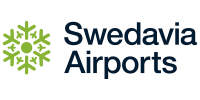Stockholm Arlanda Airport RNP Project (SAARP)
Timeline

Description
Overview
The project will in accordance with EU Commission Implementing Rule No 716/2014 (PCP regulation) design and deploy Required Air Navigation Performance 1 Standard Arrival Routes (RNP1-STARs), initially intended to be used during low density traffic at Stockholm Arlanda Airport. The high level objective is to design these STARs to enable Continuous Descent Operations (CDO). The STARs will be designed from all Terminal Control Area (TMA) entry points (4 in total) to all runway ends, in a continuum (closed path) via RNP Approach procedures (LNAV/VNAV & LPV minima’s).
The project will be conducted in close collaboration with all relevant stakeholders (e.g. the local ANSP as well as working in close collaboration with one local Airspace User; Nova Airlines AB). The newly designed flight procedures will be modelled, followed by a flyability check, including flight simulation in an Airbus A320 family simulator prior to flight trials and deployment (i.e. publication in the Swedish AIP). The objective with the SBAS procedures (LPV minima) is to aim for as low Obstacle Clearance Height (OCH) as possible (200 ft), detailed procedure design will determine the outcome of this.
Swedavia will work in partnership with the Airspace User Nova Airlines AB (Novair) throughout the complete RNP project at Stockholm Arlanda Airport. By collaborating with one of the end users, this will ensure that flyable and operational feasible flight procedures will be designed, developed and validated prior to deployment.
Specific Objectives
This Implementation project aims to:
implement and publish RNP-1 based STARs to all runway ends at Stockholm Arlanda Airport (i.e. 6x4 routes for a total of 24 STAR procedures).
implement and publish RNP approaches with vertical guidance designed (LNAV/VNAV and LPV). The latter is aimed to be down to 200 ft. decision altitude, but final design will determine the outcome.
define which procedures to be developed, its geographical layout etc. with the high-level objective to be published in the Swedish AIP (Aeronautical Information Publication) first phase.
design the procedures and test them through modelling and then assure the flyability of them through flight simulation and flight trials (second phase)
carry out an environmental assessment of gaseous emissions associated with the new procedures
validate the complete set of procedures by carrying out operational and safety workshops with pilots, safety officers and ATCOs.
Involve the Swedish regulator in the approval of the procedures.
train the controllers and develop briefing material to Airspace Users in parallel with the preparation and publication.
Expected results
The following results are expected:
RNP-1 based STARs to all runway ends at Stockholm Arlanda Airport (i.e. 6x4 routes for a total of 24 STAR procedures) are published and implemented.
RNP approaches with vertical guidance are designed (LNAV/VNAV and LPV), published and implemented. The latter is aimed to be down to 200 ft. decision altitude, but final design will determine the outcome.
Procedures are defined including geographical layout etc. with the high-level objective to be published in the Swedish AIP (first phase)
Procedures are designed and tested through modelling and assuring flyability through flight simulation and flight trials (second phase)
Environmental assessment of gaseous emissions associated with the new procedures is carried out
The complete set of procedures is validated by carrying out operational and safety workshops with pilots, safety officers and ATCOs.
Involvement of the Swedish regulator is ensured in the approval of the procedures.
Training of the controllers and development briefing material to Airspace Users is carried out in parallel with the preparation and publication
Performance benefits
Fewer/Less tactical interventions/less radar vectoring by the ATCOs and increased adherence to the STAR procedures are expected as the main benefits.
Additional Information provided by the Project Manager:
Novair has been very active in the PBN domain for over a decade and has been involved in various SESAR 1 projects related to PBN, and has conducted pioneering activities in the PBN domain in Europe, and will therefore take an active role in this project as a partner to Swedavia.
Countries involved
Additional Information
- Project Type: Airport
- CEF Call Year: 2016
- Civil/Military: Civil
- Multistakeholder: Yes
- Main AF: AF1 - Extended Arrival Management and Performance Based Navigation in high density Terminal Manoeuvring Area
- Sub AF: S-AF 1.2 - Enhanced Terminal Airspace using RNP-Based Operations
- Progress Percentage: 100%
